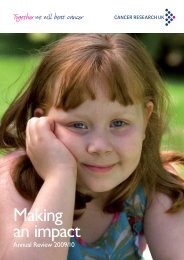Cancer Awareness in Hertfordshire, Luton and South Bedfordshire
Cancer Awareness in Hertfordshire, Luton and South Bedfordshire
Cancer Awareness in Hertfordshire, Luton and South Bedfordshire
- No tags were found...
Create successful ePaper yourself
Turn your PDF publications into a flip-book with our unique Google optimized e-Paper software.
Cover PageResearchReport<strong>Cancer</strong> <strong>Awareness</strong> <strong>in</strong><strong>Hertfordshire</strong>, <strong>Luton</strong> <strong>and</strong><strong>South</strong> <strong>Bedfordshire</strong>Prepared for: Mount Vernon <strong>Cancer</strong>Network
<strong>Cancer</strong> <strong>Awareness</strong> <strong>in</strong> <strong>Hertfordshire</strong>, <strong>Luton</strong> <strong>and</strong> <strong>South</strong><strong>Bedfordshire</strong>Prepared for: Mount Vernon <strong>Cancer</strong> NetworkPrepared by: Jenna Allen, Associate Account DirectorSeptember 2010Produced by BMG Research© Bostock Market<strong>in</strong>g Group Ltd, 2010www.bmgresearch.co.ukProject: 7914Registered <strong>in</strong> Engl<strong>and</strong> No. 2841970Registered office:7 Holt Court NorthHeneage Street WestAston Science ParkBirm<strong>in</strong>ghamB7 4AXUKTel: +44 (0) 121 3336006UK VAT Registration No. 580 6606 32Birm<strong>in</strong>gham Chamber of Commerce Member No. B4626Market Research Society Company PartnerESOMAR Member (The World Association of Research Professionals)British Quality Foundation MemberMarket Research Quality St<strong>and</strong>ards Association (British St<strong>and</strong>ards Institute) BS7911 for Market Research -Certificate No. FS76713Investors <strong>in</strong> People St<strong>and</strong>ard - Certificate No. WMQC 0614Interviewer Quality Control Scheme (IQCS) Member CompanyRegistered under the Data Protection Act - Registration No. Z5081943The BMG Research logo is a trade mark of Bostock Market<strong>in</strong>g Group Ltd
<strong>Cancer</strong> <strong>Awareness</strong> <strong>in</strong> <strong>Hertfordshire</strong>, <strong>Luton</strong> <strong>and</strong> <strong>South</strong> <strong>Bedfordshire</strong>Table of Contents1 Introduction .................................................................................................................... 31.1 Background............................................................................................................. 31.2 Survey Method ........................................................................................................ 31.3 Data ........................................................................................................................ 51.4 Report<strong>in</strong>g ................................................................................................................ 62 <strong>Awareness</strong> of warn<strong>in</strong>g signs of cancer ........................................................................... 72.1 Introduction ............................................................................................................. 72.2 Unprompted awareness of warn<strong>in</strong>g signs ............................................................... 72.3 Recognition of warn<strong>in</strong>g signs of cancer (prompted)............................................... 103 Contact<strong>in</strong>g the doctor ................................................................................................... 133.1 Anticipated delays before contact<strong>in</strong>g the doctor .................................................... 133.2 Reasons for delay<strong>in</strong>g a visit to the doctor .............................................................. 164 <strong>Awareness</strong> of cancer risk factors ................................................................................. 204.1 Recall of risk factors for cancer (unprompted)....................................................... 204.2 Recognition of risk factors for cancer (prompted).................................................. 224.3 Contribut<strong>in</strong>g factors ............................................................................................... 244.4 Knowledge of lifetime risk of cancer ...................................................................... 255 Knowledge of the most common cancers ..................................................................... 275.1 Most common cancers <strong>in</strong> women .......................................................................... 275.2 Most common cancers <strong>in</strong> men .............................................................................. 286 Knowledge of NHS cancer screen<strong>in</strong>g programmes ...................................................... 306.1 Introduction ........................................................................................................... 306.2 NHS breast cancer screen<strong>in</strong>g programme ............................................................ 306.3 NHS cervical cancer screen<strong>in</strong>g programme (smear tests) ..................................... 316.4 NHS bowel cancer screen<strong>in</strong>g programme ............................................................. 347 Conclusions ................................................................................................................. 368 <strong>Cancer</strong> awareness campaign effectiveness ................................................................. 378.1 Spontaneous awareness of warn<strong>in</strong>g signs ............................................................ 388.2 Prompted awareness of warn<strong>in</strong>g signs.................................................................. 408.3 Recognition of risk factors for cancer (prompted).................................................. 418.4 <strong>Awareness</strong> of cancer screen<strong>in</strong>g programmes ....................................................... 42
8.5 Lifestyle as a cancer contribut<strong>in</strong>g factor ................................................................ 428.6 Conclusion ............................................................................................................ 439 Profile of sample .......................................................................................................... 4410 Appendix 1: Leaflet ................................................................................................... 4611 Appendix 2: Cover<strong>in</strong>g letter ...................................................................................... 4812 Appendix 3: Probability of develop<strong>in</strong>g cancer (out of 100) ........................................ 49Table of FiguresFigure 1: There are many warn<strong>in</strong>g signs <strong>and</strong> symptoms of cancer. Please name as many asyou can th<strong>in</strong>k of (unprompted) (All respondents) ................................................................... 8Figure 2: Do you th<strong>in</strong>k that the follow<strong>in</strong>g could be a sign of cancer? (All respondents) ........ 10Figure 3: If you noticed (symptom) how soon would you contact your doctor to make anappo<strong>in</strong>tment to discuss it? ................................................................................................... 13Figure 4: These are some of the reasons people give for delay<strong>in</strong>g go<strong>in</strong>g to see the doctor.Could you say if any of these might put you off go<strong>in</strong>g to the doctor? (All respondents) ....... 16Figure 5: Barriers to help-seek<strong>in</strong>g – difficulty <strong>in</strong> mak<strong>in</strong>g appo<strong>in</strong>tment with the doctor .......... 17Figure 6: Barriers to help-seek<strong>in</strong>g – worried about what doctor might f<strong>in</strong>d ........................... 18Figure 7: What th<strong>in</strong>gs do you th<strong>in</strong>k affect a person’s chance of gett<strong>in</strong>g cancer? (Unprompted)(All respondents) ................................................................................................................. 21Figure 8: Medical scientists suggest that these are some of the th<strong>in</strong>gs that can <strong>in</strong>crease thechance of gett<strong>in</strong>g cancer. How much do you agree that each of these can <strong>in</strong>crease thechance of gett<strong>in</strong>g cancer? (All respondents) ....................................................................... 22Figure 9: Please put the follow<strong>in</strong>g <strong>in</strong> order of how much you th<strong>in</strong>k they contribute to cancer <strong>in</strong>the UK (All respondents) ..................................................................................................... 24Figure 10: Out of 100 people, how many do you th<strong>in</strong>k will develop cancer at some po<strong>in</strong>t <strong>in</strong>their life (All respondents) ................................................................................................... 25Figure 11: What do you th<strong>in</strong>k is the most common cancer <strong>in</strong> women? Second mostcommon? Third most common? (All respondents) .............................................................. 27Figure 12: What do you th<strong>in</strong>k is the most common cancer <strong>in</strong> men? Second most common?Third most common (All respondents) ................................................................................. 28Figure 13: Is there an NHS breast cancer screen<strong>in</strong>g programme? % yes (All respondents) 30Figure 14: At what age are women first <strong>in</strong>vited for breast cancer screen<strong>in</strong>g? (All respondentsthat state there is a breast cancer screen<strong>in</strong>g programme) ................................................... 31Figure 15: Is there an NHS cervical cancer screen<strong>in</strong>g programme? % yes (All respondents)........................................................................................................................................... 32
<strong>Cancer</strong> <strong>Awareness</strong> <strong>in</strong> <strong>Hertfordshire</strong>, <strong>Luton</strong> <strong>and</strong> <strong>South</strong> <strong>Bedfordshire</strong>Figure 16: At what age are women first <strong>in</strong>vited for cervical cancer screen<strong>in</strong>g? (Allrespondents that state there is a cervical cancer screen<strong>in</strong>g programme) ............................ 33Figure 17: Is there an NHS bowel cancer screen<strong>in</strong>g programme? % yes (All respondents) 34Figure 18: At what age are people first <strong>in</strong>vited for bowel cancer screen<strong>in</strong>g? (All respondentsthat state there is a bowel cancer screen<strong>in</strong>g programme) ................................................... 35Table of TablesTable 1: Number of returns <strong>and</strong> confidence <strong>in</strong>terval per survey area ..................................... 5Table 2: Unprompted awareness of warn<strong>in</strong>g signs / symptoms of cancer ............................. 9Table 3: Prompted awareness of signs/symptoms of cancer? ............................................. 12Table 4: Delay <strong>in</strong> present<strong>in</strong>g symptoms to the doctor (All respondents) .............................. 14Table 5: Delay <strong>in</strong> present<strong>in</strong>g symptoms to the doctor .......................................................... 15Table 6: Barriers to help-seek<strong>in</strong>g ........................................................................................ 19Table 7: Recognition of cancer risk factors .......................................................................... 23Table 8: Spontaneous recall of warn<strong>in</strong>g signs / symptoms of cancer (All mentions by surveyarea – All responses) .......................................................................................................... 38Table 9: Prompted recognition of warn<strong>in</strong>g signs / symptoms of cancer .............................. 40Table 10: Recognition of risk factors for cancer ................................................................... 41Table 11: <strong>Awareness</strong> of cancer screen<strong>in</strong>g programmes ...................................................... 42Table 12: Lifestyle as a cancer contributor .......................................................................... 42Table 13: Demographic profile (ma<strong>in</strong> sample) ..................................................................... 44Table 14: Have you or your family or close friends had cancer? (All respondents) .............. 45
Introduction1 Introduction1.1 BackgroundThis report summarises the results of a survey of cancer awareness across the MountVernon cancer network area, carried out by BMG Research <strong>in</strong> 2010. The MountVernon cancer network is made up of <strong>Luton</strong>, <strong>South</strong> <strong>Bedfordshire</strong>, West <strong>Hertfordshire</strong><strong>and</strong> East <strong>and</strong> North <strong>Hertfordshire</strong> Primary Care Trusts. The survey took place prior tothe merger of the two <strong>Hertfordshire</strong> PCTs.The survey was carried out us<strong>in</strong>g the <strong>Cancer</strong> Research UK <strong>Cancer</strong> <strong>Awareness</strong>Measure, a validated <strong>in</strong>strument developed by University College London, K<strong>in</strong>g’sCollege London <strong>and</strong> University of Oxford. It is used to assess level of awareness <strong>and</strong>anticipated help-seek<strong>in</strong>g behaviour amongst the public <strong>in</strong> relation to cancer.The questionnaire <strong>in</strong>cluded questions relat<strong>in</strong>g to:Knowledge of the warn<strong>in</strong>g signs <strong>and</strong> symptoms of cancer;Anticipated delays before contact<strong>in</strong>g a doctor;Barriers to seek<strong>in</strong>g medical advice;Knowledge of risk factors of cancer;Knowledge of lifetime risk of cancer;Knowledge of most common cancers; <strong>and</strong>Knowledge of NHS screen<strong>in</strong>g programmes.1.2 Survey MethodA total of 2,018 <strong>in</strong>terviews were conducted face-to-face with residents us<strong>in</strong>g CAPI(Computer Aided Personal Interview<strong>in</strong>g) technology. Interviews took place betweenFebruary <strong>and</strong> May 2010. Dur<strong>in</strong>g <strong>in</strong>terview<strong>in</strong>g, quotas were set for PCT, age, gender<strong>and</strong> ethnicity to ensure the sample represented as closely as possible the populationof the Mount Vernon cancer network area. Upon completion of the <strong>in</strong>terview,respondents were provided with an <strong>in</strong>formation sheet which gave them the answers tothe questions conta<strong>in</strong>ed with<strong>in</strong> the <strong>in</strong>terview, as well as provid<strong>in</strong>g details of supportservices should they require further <strong>in</strong>formation or wish to discuss anyth<strong>in</strong>g that thesurvey had highlighted. The <strong>in</strong>terviews lasted an average of 15 m<strong>in</strong>utes.1.2.1 Sampl<strong>in</strong>gThe target population for the survey was the adult population (18+) of the MountVernon cancer network area. The survey was conducted via a household face-to-facemethodology, us<strong>in</strong>g a stratified r<strong>and</strong>om sample obta<strong>in</strong>ed from the Royal Mail’sPostcode Address File (PAF). The sample was selected by stratify<strong>in</strong>g Super OutputAreas (SOAs) accord<strong>in</strong>g to their deprivation qu<strong>in</strong>tile <strong>and</strong> then select<strong>in</strong>g every ‘nth’address with<strong>in</strong> the selected SOAs. Fixed <strong>in</strong>terview<strong>in</strong>g targets were set by PCT <strong>in</strong>proportion to the resident population. In addition, responses were also monitored byage, gender <strong>and</strong> ethnicity to ensure the survey was representative of the residentpopulation. Interviews were conducted weekdays, weekends <strong>and</strong> even<strong>in</strong>gs to ensure arepresentative sample. All sampled households were visited up to a further three times3
<strong>Cancer</strong> <strong>Awareness</strong> <strong>in</strong> <strong>Hertfordshire</strong>, <strong>Luton</strong> <strong>and</strong> <strong>South</strong> <strong>Bedfordshire</strong>if the <strong>in</strong>itial knock did not illicit a response. To further ensure the r<strong>and</strong>omness of thesample, respondents were selected us<strong>in</strong>g the birthday rule, whereby the <strong>in</strong>terview wasconducted with the person aged over 18 years who has had their birthday mostrecently.A unique sampl<strong>in</strong>g strategy was applied for this study, which <strong>in</strong>corporated a number ofboost areas, with set targets with<strong>in</strong> each:Ma<strong>in</strong> sample: The target for the ma<strong>in</strong> sample was 1,000 <strong>in</strong>terviews <strong>and</strong> thesewere to cover the entire Mount Vernon cancer network area us<strong>in</strong>g the sampl<strong>in</strong>gstrategy described above. A total of 1,002 <strong>in</strong>terviews were conducted <strong>in</strong> total.Intervention area: The Mount Vernon <strong>Cancer</strong> Network was <strong>in</strong>terested <strong>in</strong> explor<strong>in</strong>gthe impact of send<strong>in</strong>g out an <strong>in</strong>formation leaflet to residents <strong>in</strong> advance of thesurvey tak<strong>in</strong>g place (leaflet shown <strong>in</strong> Appendix 1). This leaflet <strong>in</strong>formed residentsof the symptoms of cancer as well as health promotion advice. The MountVernon <strong>Cancer</strong> Network was responsible for distribut<strong>in</strong>g these leaflets <strong>and</strong>provided BMG Research with the necessary postcodes from which to sample the<strong>in</strong>terviews. Interview<strong>in</strong>g took place at least 4 weeks after the delivery of theleaflets. A total of 507 <strong>in</strong>terviews were conducted <strong>in</strong> Watford.Control area 1: To be able to give a valid measurement of the impact of theleaflets on resident awareness of cancer, a control area was selected to closelyreflect the attributes of the <strong>in</strong>tervention area (for example, by deprivation,education atta<strong>in</strong>ment levels <strong>and</strong> type of area). 5 SOAs were selected for <strong>in</strong>clusion<strong>in</strong> the sample, all of which were located <strong>in</strong> <strong>Luton</strong>. A total of 249 <strong>in</strong>terviews wereconducted <strong>in</strong> this area.Intervention area 2: An additional requirement was to explore the impact of notonly send<strong>in</strong>g an <strong>in</strong>formation leaflet to residents, but to also enclose a cover<strong>in</strong>gletter signed off by the Network Director <strong>and</strong> the primary care lead (see Appendix2). The hypothesis be<strong>in</strong>g that residents would be more <strong>in</strong>cl<strong>in</strong>ed to read the leaflet<strong>and</strong> hence demonstrate higher levels of awareness. Aga<strong>in</strong>, 5 SOAs wereselected as the sampl<strong>in</strong>g areas, <strong>and</strong> were chosen because they display the samecharacteristics as the <strong>in</strong>tervention area <strong>and</strong> control area 1. A total of 254<strong>in</strong>terviews were conducted <strong>in</strong> this area.The follow<strong>in</strong>g table gives a summary of the number of <strong>in</strong>terviews conducted <strong>in</strong> each ofthe different survey areas <strong>and</strong> the associated confidence we have <strong>in</strong> the data:4
IntroductionTable 1: Number of returns <strong>and</strong> confidence <strong>in</strong>terval per survey areaSurvey areaNumber of completed<strong>in</strong>terviewsConfidence <strong>in</strong>tervalMa<strong>in</strong> sample 1002 +/-3.1%Control area 1 (no letter orleaflet sent)249 +/-6.2%Intervention area (leaflet sent) 507 +/-4.4%Intervention area 2 (letter <strong>and</strong>leaflet sent)254 +/-6.1%Total 2018 +/-2.2%1.2.2 Questionnaire designThe CAM is a validated questionnaire <strong>and</strong> as such is st<strong>and</strong>ardised to ensureconsistency <strong>and</strong> comparability of data. However, upon review of the questionnairesome issues were raised by BMG Research with <strong>Cancer</strong> Research UK, who designedthe validated questionnaire, <strong>and</strong> m<strong>in</strong>or changes to its design were approved. Thesechanges did not affect any of the questions asked or reduce the data comparabilitywith surveys conducted <strong>in</strong> other areas.1.3 DataIn total, 2,018 <strong>in</strong>terviews were completed with respondents aged 18+ years. Thesample size of 2,018 is subject to a maximum st<strong>and</strong>ard error of ±2.2% at the 95%confidence level on an observed statistic of 50%. Thus, for the quantitative survey, wecan be 95% confident that responses are representative of those that would be givenby the total population of Mount Vernon, if a census had been conducted, to with<strong>in</strong>±2.2% of the percentages reported.This means that if the total population of Mount Vernon had completed the survey <strong>and</strong>a statistic of 50% was observed, we can be 95% confident that the response liesbetween 47.8% <strong>and</strong> 52.2%.1.3.1 Weight<strong>in</strong>gTo ensure that the results are representative of the population, the data has beenweighted by PCT, gender, age, <strong>and</strong> ethnicity to match the 2001 Census data.Weight<strong>in</strong>g is a statistical technique used to counteract the deviations that occur <strong>in</strong>survey samples aga<strong>in</strong>st the population as a whole. In this case, weight<strong>in</strong>g by PCT,age, ethnicity <strong>and</strong> gender has been used to ensure that the sample used herecorresponds to the overall population of Mount Vernon.At its most basic level, this means that if a national survey of 1,000 people is made upof 550 men <strong>and</strong> 450 women, then the survey is unrepresentative of the UK populationas 51% is female. Therefore weight<strong>in</strong>g would be applied to give the responses fromfemale respondents slightly more weight (<strong>in</strong> this case each female respondent wouldbe equivalent to 1.133 people) to give them a representative impact on the f<strong>in</strong>alresults. Conversely, men would be weighted to each count as 0.891 so that theirresponses were not over represented <strong>in</strong> the f<strong>in</strong>al data.5
<strong>Cancer</strong> <strong>Awareness</strong> <strong>in</strong> <strong>Hertfordshire</strong>, <strong>Luton</strong> <strong>and</strong> <strong>South</strong> <strong>Bedfordshire</strong>1.4 Report<strong>in</strong>gThroughout this report the word significant is used to describe differences <strong>in</strong> the data.This <strong>in</strong>dicates where the data has been tested for statistical significance. This test<strong>in</strong>gidentifies ‘real differences’ (i.e. differences that would occur if we were able to<strong>in</strong>terview all residents <strong>in</strong> the borough rather than just a sample). However, as alreadynoted the actual percentages reported <strong>in</strong> the data may vary by ±2.2% at the 95%confidence level on an observed statistic of 50%.Figures <strong>and</strong> tables are used throughout the report to assist explanation <strong>and</strong> analysis.Although occasional anomalies appear due to ‘round<strong>in</strong>g’ differences, these are nevermore than +/-1%. These occur where rat<strong>in</strong>g scales have been added to calculateproportions of respondents who agree at all (i.e. either agree or strongly agree).On receipt of each completed questionnaire, BMG coded the verbatim (open-ended)questions, <strong>in</strong>put <strong>and</strong> then analysed the data. Throughout this report there is analysis atboth a total <strong>and</strong> sub sample level, e.g. gender, ethnicity, age <strong>and</strong> economic status.Important: The majority of the results <strong>in</strong>cluded with<strong>in</strong> the report are based on thecomb<strong>in</strong>ed figures of those residents <strong>in</strong>terviewed <strong>in</strong> the ma<strong>in</strong> <strong>and</strong> control area 1samples (n=1251). This is because these residents had not been given any healthpromotional material prior to the survey commenc<strong>in</strong>g. These are the results that are tobe fed back to <strong>Cancer</strong> Research UK as part of the st<strong>and</strong>ardised CAM survey process.However, where necessary, tables / graphs have been provided that present thecomparisons between the different survey areas, as a means of identify<strong>in</strong>g whetherpromotional materials sent out to the <strong>in</strong>tervention area <strong>and</strong> <strong>in</strong>tervention area 2 had animpact on responses.6
<strong>Awareness</strong> of warn<strong>in</strong>g signs of cancer2 <strong>Awareness</strong> of warn<strong>in</strong>g signs of cancer2.1 IntroductionThe follow<strong>in</strong>g section explores resident awareness of the warn<strong>in</strong>g signs of cancer.2.2 Unprompted awareness of warn<strong>in</strong>g signsAll respondents were asked to name as many warn<strong>in</strong>g signs <strong>and</strong> symptoms of canceras they could th<strong>in</strong>k of. The first mentioned sign or symptom was recorded separatelyto enable analysis of the top of m<strong>in</strong>d awareness.The most highly recalled warn<strong>in</strong>g sign or symptom of cancer is the classic tumoursymptom of a lump or swell<strong>in</strong>g <strong>and</strong> this is spontaneously mentioned by around threequarters of the sample (74%). All other symptoms were recalled at comparatively lowerlevels, around two fifths mentioned pa<strong>in</strong> (41%), a third the change <strong>in</strong> appearance of amole (34%) <strong>and</strong> a quarter, bleed<strong>in</strong>g (27%). Only 6% of respondents mention a sorethat doesn’t heal or, difficulty swallow<strong>in</strong>g. On average, 2.84 symptoms were recalled,but the symptom that ga<strong>in</strong>s the highest top of m<strong>in</strong>d awareness, i.e. the symptom that ismost tightly associated with cancer is a lump or swell<strong>in</strong>g <strong>and</strong> this is the first mentionedcancer warn<strong>in</strong>g sign or symptom by just over half of all respondents (54%). Pa<strong>in</strong> <strong>and</strong>the chang<strong>in</strong>g appearance of a mole were the first recalled cancer symptom by justover one <strong>in</strong> ten (11% <strong>and</strong> 12% respectively). Full details of the first mentioned <strong>and</strong> allmentioned symptoms are provided <strong>in</strong> the chart below.7
<strong>Cancer</strong> <strong>Awareness</strong> <strong>in</strong> <strong>Hertfordshire</strong>, <strong>Luton</strong> <strong>and</strong> <strong>South</strong> <strong>Bedfordshire</strong>Figure 1: There are many warn<strong>in</strong>g signs <strong>and</strong> symptoms of cancer. Please name asmany as you can th<strong>in</strong>k of (unprompted) (All respondents)Lump / swell<strong>in</strong>gPa<strong>in</strong>Change <strong>in</strong> appearance of a moleBleed<strong>in</strong>gChange <strong>in</strong> bowel / bladder habitsWeight lossCough / hoarsenessTiredness / fatigueSore that does not healDifficulty swallow<strong>in</strong>gGenerally unwellNausea / sicknessLoss of appetiteOtherNoth<strong>in</strong>gRefusalDon't know11%12%2%16%2%14%3%8%1%7%1%6%1%6%*6%*5%*4%*1%*3%3%**8%8%27%54%41%34%All mentionsFirst mentionMean Number ofSymptoms Recalled2.8474%0% 20% 40% 60% 80%Unweighted base: 1251 * denotes
<strong>Awareness</strong> of warn<strong>in</strong>g signs of cancerAnalysis by PCT shows higher levels of spontaneous awareness of cancer warn<strong>in</strong>gsigns with<strong>in</strong> both <strong>Luton</strong> PCT <strong>and</strong> <strong>South</strong> <strong>Bedfordshire</strong> PCT (98% mentioned asymptom) when compared to the East <strong>and</strong> North <strong>Hertfordshire</strong> PCT (80% mentioned asymptom) or West <strong>Hertfordshire</strong> PCT (84%). There is also an <strong>in</strong>creased depth ofawareness of cancer symptoms <strong>in</strong> both <strong>Luton</strong> <strong>and</strong> <strong>South</strong> <strong>Bedfordshire</strong> with participants<strong>in</strong> these areas each recall<strong>in</strong>g a greater number of symptoms (3.23 <strong>and</strong> 3.24respectively).Table 2: Unprompted awareness of warn<strong>in</strong>g signs / symptoms of cancer(All mentions by PCT – All responses) * denotes
<strong>Cancer</strong> <strong>Awareness</strong> <strong>in</strong> <strong>Hertfordshire</strong>, <strong>Luton</strong> <strong>and</strong> <strong>South</strong> <strong>Bedfordshire</strong>2.3 Recognition of warn<strong>in</strong>g signs of cancer (prompted)Respondents were then read a list of different symptoms, such as an unexpla<strong>in</strong>edlump or swell<strong>in</strong>g, or persistent unexpla<strong>in</strong>ed pa<strong>in</strong>, <strong>and</strong> asked if they thought each werea warn<strong>in</strong>g sign of cancer. ‘Persistent’ <strong>in</strong> reference to any of the warn<strong>in</strong>g signs refers to3 weeks or longer.Prompted recognition of symptoms gave a considerably higher score than recall. Alump or swell<strong>in</strong>g (93%) <strong>and</strong> changes <strong>in</strong> bowel or bladder habits (90%) were the mostrecognised signs, identified by more than n<strong>in</strong>e <strong>in</strong> ten respondents. Even the leastrecognised potential warn<strong>in</strong>g sign, persistent difficulty <strong>in</strong> swallow<strong>in</strong>g, wasacknowledged by two thirds of participants (65%). The mean number of symptomsrecognised was 7.4 out of 9.Review<strong>in</strong>g the level of prompted recognition to spontaneous recall identifies thewarn<strong>in</strong>g signs or symptoms that participants would most readily associate with canceri.e. a lump or swell<strong>in</strong>g (93%:74%) <strong>and</strong> persistent unexpla<strong>in</strong>ed pa<strong>in</strong> (81%:41%). A sorethat doesn’t heal reveals the highest ratio of prompted recognition to spontaneousmention (77%:6%).Figure 2: Do you th<strong>in</strong>k that the follow<strong>in</strong>g could be a sign of cancer? (All respondents)Lump or swell<strong>in</strong>gPersistent change <strong>in</strong> bowelor bladder habitsChange <strong>in</strong> the appearance ofa mole93%90%88%Spontaneousrecall74%16%34%Unexpla<strong>in</strong>ed bleed<strong>in</strong>g87%27%Unexpla<strong>in</strong>ed weight loss82%14%Persistent unexpla<strong>in</strong>ed pa<strong>in</strong>81%41%A sore that does not healPersistent cough orhoarsenessPersistent difficultyswallow<strong>in</strong>g65%77%74%6%8%6%0% 20% 40% 60% 80% 100%Unweighted base = 125110
<strong>Awareness</strong> of warn<strong>in</strong>g signs of cancerWomen showed similar levels of recognition for each symptom when compared to men<strong>and</strong> the mean number of symptoms recognised was also comparable (7.4 recognisedby men, 7.48 recognised by women). Whilst not always a significant variance, thepattern of data shows that older respondents were more likely to recognise warn<strong>in</strong>gsigns than the younger 18-24 year old respondents <strong>and</strong> this was true for lumps orswell<strong>in</strong>gs, unexpla<strong>in</strong>ed pa<strong>in</strong>, bleed<strong>in</strong>g, changes <strong>in</strong> bowel or bladder habits, difficultyswallow<strong>in</strong>g, change <strong>in</strong> appearance of a mole, a sore that doesn’t heal <strong>and</strong> weight loss.For example, 79% of 18-24 year olds recognised that a change <strong>in</strong> the appearance of amole could be a sign of cancer, a significantly lower proportion than those aged 25years or above (87% 25-44 years, 91% 45-64 years <strong>and</strong> 89% 65+ years).In addition, those from a Black <strong>and</strong> M<strong>in</strong>ority Ethnic (BME) background had significantlylower levels of cancer warn<strong>in</strong>g sign recognition than non BME for all symptomsexcept<strong>in</strong>g a persistent cough, difficulty swallow<strong>in</strong>g <strong>and</strong> a sore that doesn’t heal. Forexample, 94% of non BME respondents recognised an unexpla<strong>in</strong>ed lump or swell<strong>in</strong>gcould be a sign of cancer, compared to 86% of BME respondents. Count<strong>in</strong>g thenumber of symptoms recognised, non BME respondents were familiar with moresymptoms (7.51 out of 9) than the BME (7.22 out of 9).Level of education did not appear to be a factor <strong>in</strong>fluenc<strong>in</strong>g recognition of cancerwarn<strong>in</strong>g signs. Compar<strong>in</strong>g those respondents who had been educated beyondO’levels/GCSEs to those educated only towards O’level/GCSEs, there were nosignificant differences <strong>in</strong> the proportion recognis<strong>in</strong>g each potential sign of cancer.However, perhaps unsurpris<strong>in</strong>gly, respondents that have themselves, a family memberor friend had cancer are more likely to be aware of each of the signs of cancer.Analysis by PCT shows the East <strong>and</strong> North <strong>Hertfordshire</strong> PCT participants have alower level of prompted awareness of cancer warn<strong>in</strong>g signs or symptoms than all otherPCT areas. The <strong>South</strong> <strong>Bedfordshire</strong> PCT <strong>in</strong> particular has significantly higherprompted levels of recognition for six of the symptom types; this is denoted by thebold, underl<strong>in</strong>ed figures <strong>in</strong> the table below, <strong>in</strong> comparison to those figures underl<strong>in</strong>edbut not <strong>in</strong> bold (i.e. the significantly lowest figures).11
<strong>Cancer</strong> <strong>Awareness</strong> <strong>in</strong> <strong>Hertfordshire</strong>, <strong>Luton</strong> <strong>and</strong> <strong>South</strong> <strong>Bedfordshire</strong>Table 3: Prompted awareness of signs/symptoms of cancer?(by PCT - All responses)East <strong>and</strong>North HertsWest Herts<strong>Luton</strong><strong>South</strong><strong>Bedfordshire</strong>Lump or swell<strong>in</strong>g 91% 93% 93% 98%Persistent unexpla<strong>in</strong>ed pa<strong>in</strong> 76% 78% 87% 90%Unexpla<strong>in</strong>ed bleed<strong>in</strong>g 82% 86% 90% 89%Persistent cough or hoarseness 67% 71% 82% 81%Persistent change <strong>in</strong> bowel orbladder habits 87% 91% 89% 94%Persistent difficulty swallow<strong>in</strong>g 63% 65% 68% 66%Change <strong>in</strong> the appearance of a mole 84% 90% 87% 97%A sore that does not heal 70% 75% 84% 84%Unexpla<strong>in</strong>ed weight loss 80% 82% 82% 86%Unweighted base 402 380 382 8712
Contact<strong>in</strong>g the doctor3 Contact<strong>in</strong>g the doctor3.1 Anticipated delays before contact<strong>in</strong>g the doctorRespondents were presented with a range of symptoms <strong>and</strong> asked if they were tohave any of these symptoms how long it would be before they contacted their doctor tomake an appo<strong>in</strong>tment.Few respondents anticipated they would delay contact<strong>in</strong>g their doctor beyond a weekto discuss any of the prompted symptoms, with the large majority stat<strong>in</strong>g that theywould contact their doctor with<strong>in</strong> a two week period. Full details of the anticipateddelay <strong>in</strong> contact<strong>in</strong>g the doctor are provided <strong>in</strong> the table overleaf.Figure 3: If you noticed (symptom) how soon would you contact your doctor to makean appo<strong>in</strong>tment to discuss it?(2 week summary - All responses)With<strong>in</strong> a week2 weeksUnexpla<strong>in</strong>ed bleed<strong>in</strong>gA symptom that you thoughtmight be a sign of cancerUnexpla<strong>in</strong>ed lump or swell<strong>in</strong>gDifficulty swallow<strong>in</strong>gChange <strong>in</strong> the appearance of amoleUnexpla<strong>in</strong>ed pa<strong>in</strong>Change <strong>in</strong> bowel or bladderhabitsSore that did not healPersistent cough orhoarsenessUnexpla<strong>in</strong>ed weight loss96%94%91%91%91%89%88%87%81%77%3%3%5%7%5%7%6%8%10%10%0% 20% 40% 60% 80% 100%Unweighted base = 1251Unexpla<strong>in</strong>ed bleed<strong>in</strong>g, a lump or swell<strong>in</strong>g, or a symptom that the respondent thoughtmay be a sign of cancer were associated with the least delay <strong>in</strong> present<strong>in</strong>g thesymptom to a doctor, with two thirds of respondents claim<strong>in</strong>g that they would seek helpwith<strong>in</strong> 1-3 days. Unexpla<strong>in</strong>ed weight loss would <strong>in</strong>cur the greatest delay <strong>in</strong> approach<strong>in</strong>ga GP (12% would wait more than a month) but reflect that this may be due to thenature of the symptom which could potentially take longer to notice. Grey shad<strong>in</strong>g hasbeen used to highlight where delays are the shortest (+60% or more would visit adoctor with 1-3 days of notic<strong>in</strong>g the symptom).13
<strong>Cancer</strong> <strong>Awareness</strong> <strong>in</strong> <strong>Hertfordshire</strong>, <strong>Luton</strong> <strong>and</strong> <strong>South</strong> <strong>Bedfordshire</strong>Table 4: Delay <strong>in</strong> present<strong>in</strong>g symptoms to the doctor (All respondents)1-3 days 4-6 days 1 week 2 weeks 1 month 6 weeks 3 months 6 months 12 months NeverDon'tknowUnexpla<strong>in</strong>ed lump or swell<strong>in</strong>gUnexpla<strong>in</strong>ed pa<strong>in</strong>Unexpla<strong>in</strong>ed bleed<strong>in</strong>gPersistent cough or hoarsenessChange <strong>in</strong> bowel or bladder habitsDifficulty swallow<strong>in</strong>gChange <strong>in</strong> the appearance of a moleSore that did not heal66% 15% 10% 5% 3% *% *% *% *% *% 0%53% 22% 14% 7% 2% *% *% *% *% *% 0%68% 19% 9% 3% 1% 0% *% 0% 0% 0% 0%46% 19% 16% 10% 4% 1% 1% *% *% 1% *%53% 22% 13% 6% 4% 1% *% 0% 0% *% 0%52% 24% 15% 7% 2% *% *% 0% 0% *% 0%59% 20% 12% 5% 2% *% 1% *% *% *% 0%49% 21% 17% 8% 4% *% *% 0% *% *% 0%Unexpla<strong>in</strong>ed weight loss49% 14% 14% 10% 6% 3% 2% *% 0% 1% 0%A symptom that you thought might be asign of cancer 67% 16% 11% 3% 2% *% *% 0% 0% *% 0%Unweighted sample bases vary *% denotes less than 0.5% Grey boxes used to highlight the highest scores14
Contact<strong>in</strong>g the doctorCompar<strong>in</strong>g those who said they would seek help promptly, with<strong>in</strong> a week, across thedemographic groups, shows no real variance between men <strong>and</strong> women with theexception of seek<strong>in</strong>g help from the doctor for unexpla<strong>in</strong>ed weight loss, where four fifths(81%) of women would contact their doctor with<strong>in</strong> a week to discuss it <strong>in</strong> comparison tojust three quarters of men (76%).Older people (aged 65+ years) were less likely to delay a visit to their doctor for mostsymptoms, but <strong>in</strong> particular for a cough (87% with<strong>in</strong> a week c.f. 81% 18-24 years, 79%25-64 years), a sore that won’t heal (93% with<strong>in</strong> a week c.f. 82% 18-24 years, 86%25-64 years) <strong>and</strong> unexpla<strong>in</strong>ed weight loss (87% with<strong>in</strong> a week c.f. 70% 18-24 years,76% 25-64 years).BME groups were similarly likely to report seek<strong>in</strong>g help with<strong>in</strong> a week compared to nonBME groups for most symptoms, but were significantly more likely to present apersistent cough with<strong>in</strong> a week (86% c.f. 80% non BME).Analysis by PCT shows the East <strong>and</strong> North <strong>Hertfordshire</strong> PCT participants are lesslikely to present their health problems to the doctor with<strong>in</strong> a week when compared toall other PCT areas.Table 5: Delay <strong>in</strong> present<strong>in</strong>g symptoms to the doctor(Present with<strong>in</strong> a week by PCT - All respondents)East <strong>and</strong>North HertsWest Herts<strong>Luton</strong><strong>South</strong><strong>Bedfordshire</strong>Lump or swell<strong>in</strong>g 85% 90% 96% 98%Persistent unexpla<strong>in</strong>ed pa<strong>in</strong> 81% 86% 97% 99%Unexpla<strong>in</strong>ed bleed<strong>in</strong>g 92% 94% 99% 100%Persistent cough or hoarseness 67% 77% 95% 94%Persistent change <strong>in</strong> bowel or bladderhabits78% 87% 96% 96%Persistent difficulty swallow<strong>in</strong>g 80% 88% 98% 98%Change <strong>in</strong> the appearance of a mole 84% 89% 97% 101%A sore that does not heal 77% 86% 95% 97%Unexpla<strong>in</strong>ed weight loss 63% 76% 88% 87%Symptom that may be a sign of cancer 89% 91% 100% 100%Unweighted base 402 380 382 8715
<strong>Cancer</strong> <strong>Awareness</strong> <strong>in</strong> <strong>Hertfordshire</strong>, <strong>Luton</strong> <strong>and</strong> <strong>South</strong> <strong>Bedfordshire</strong>3.2 Reasons for delay<strong>in</strong>g a visit to the doctorIt was expla<strong>in</strong>ed to respondents that sometimes people are put off go<strong>in</strong>g to see theirdoctor, even when they have a symptom that they th<strong>in</strong>k could be serious. They werethen shown a list of reasons <strong>and</strong> asked to state which, if any, would put them off go<strong>in</strong>gto see their doctor.The chart below shows that the suggested reasons that people delay a visit to thedoctors do not apply to the majority of respondents <strong>in</strong> this survey. The two highestscor<strong>in</strong>g barriers to go<strong>in</strong>g to see the doctor was the worry about what the doctor mightf<strong>in</strong>d (21%), followed by the difficulty <strong>in</strong> mak<strong>in</strong>g an appo<strong>in</strong>tment (18%).Figure 4: These are some of the reasons people give for delay<strong>in</strong>g go<strong>in</strong>g to see thedoctor. Could you say if any of these might put you off go<strong>in</strong>g to the doctor? (Allrespondents)I would be too embarrassed1% 5%93%I would be too scaredI would be worried about wast<strong>in</strong>g thedoctor's timeMy doctor would be difficult to talk toIt would be difficult to make an appo<strong>in</strong>tmentwith my doctorI would be too busy to make time to go to thedoctorI have too many other th<strong>in</strong>gs to worry aboutIt would be difficult for me to arrangetransport to the doctor's surgeryI would be worried about what the doctormight f<strong>in</strong>dI wouldn't feel confident talk<strong>in</strong>g about mysymptom with the doctor2% 7%2% 9%1% 5%4% 14%2% 9%1% 10%3% 04% 17%2% 5%91%89%93%82%89%88%96%78%93%0% 20% 40% 60% 80% 100%Yes - often Yes - sometimes NoUnweighted base = 1251The two barriers to help-seek<strong>in</strong>g identified above are quite different, the difficulty <strong>in</strong>mak<strong>in</strong>g an appo<strong>in</strong>tment with the doctor is a rational issue about service, but worry<strong>in</strong>gabout what the doctor might f<strong>in</strong>d is a more emotional response. Further analysis bydemographic group is provided on both these barriers.16
<strong>Cancer</strong> <strong>Awareness</strong> <strong>in</strong> <strong>Hertfordshire</strong>, <strong>Luton</strong> <strong>and</strong> <strong>South</strong> <strong>Bedfordshire</strong>The more emotional barrier to seek<strong>in</strong>g help, that of be<strong>in</strong>g worried about what thedoctor might f<strong>in</strong>d, shows no significant variance by gender, as men (21%) are equallylikely to raise this as an issue as women (22%). Age is however a factor with theyounger 18-24 year olds (13%) significantly less likely to express this concern whencompared to all other age groups (22% 25-44 years, 22% 45-64 years, 25% 65+years).Figure 6: Barriers to help-seek<strong>in</strong>g – worried about what doctor might f<strong>in</strong>dBy demographics (All respondents)TOTAL21%MaleFemale21%22%18-24 years25-44 years45-64 years65+ years13%22%22%25%BMENon BME17%22%Economically activeEconomically <strong>in</strong>active21%22%0% 5% 10% 15% 20% 25% 30%Unweighted base: 125118
Contact<strong>in</strong>g the doctorCompar<strong>in</strong>g reactions to all the suggested barriers to help-seek<strong>in</strong>g by PCT shows afamiliar pattern of response. The East <strong>and</strong> North <strong>Hertfordshire</strong> PCT participants aremore likely to endorse eight of the ten suggested barriers to help-seek<strong>in</strong>g at higherlevels when compared to all other PCT areas. The follow<strong>in</strong>g table highlights (bold <strong>and</strong>underl<strong>in</strong>ed) which figures per PCT are statistically significantly higher than therema<strong>in</strong><strong>in</strong>g figures (those underl<strong>in</strong>ed but not <strong>in</strong> bold). Figures not underl<strong>in</strong>ed are notstatistically significantly different to its counterpart measures.Table 6: Barriers to help-seek<strong>in</strong>gBy PCT (All respondents)East <strong>and</strong> NorthHertsWest Herts<strong>Luton</strong><strong>South</strong><strong>Bedfordshire</strong>I would be too embarrassed 18% 4% 4% 1%I would be too scared 19% 6% 5% 6%I would be worried aboutwast<strong>in</strong>g the doctor's timeMy doctor would be difficultto talk toIt would be difficult to makean appo<strong>in</strong>tment with mydoctorI would be too busy to maketime to go to the doctorI have too many other th<strong>in</strong>gsto worry aboutIt would be difficult for meto arrange transport to thedoctor's surgeryI would be worried aboutwhat the doctor might f<strong>in</strong>dI wouldn't feel confidenttalk<strong>in</strong>g about my symptomwith the doctor18% 10% 8% 8%11% 5% 5% 6%26% 18% 12% 18%19% 11% 7% 4%21% 11% 7% 6%7% 2% 4% 1%21% 19% 26% 16%9% 9% 2% 3%Unweighted base = 1251 * denotes
<strong>Cancer</strong> <strong>Awareness</strong> <strong>in</strong> <strong>Hertfordshire</strong>, <strong>Luton</strong> <strong>and</strong> <strong>South</strong> <strong>Bedfordshire</strong>4 <strong>Awareness</strong> of cancer risk factors4.1 Recall of risk factors for cancer (unprompted)Initially, respondents were asked what th<strong>in</strong>gs they th<strong>in</strong>k affect a person’s chance ofgett<strong>in</strong>g cancer. Interviewers were <strong>in</strong>structed to give respondents time to th<strong>in</strong>k abouttheir response <strong>and</strong> to keep ask<strong>in</strong>g if they could th<strong>in</strong>k of anyth<strong>in</strong>g else until therespondent could th<strong>in</strong>k of no more risk factors. The follow<strong>in</strong>g chart provides both thefirst mentioned risk factor <strong>and</strong> the comb<strong>in</strong>ed mentions.As might be expected, spontaneous recall of smok<strong>in</strong>g as a risk factor was high (89%),with smok<strong>in</strong>g dom<strong>in</strong>at<strong>in</strong>g the top of m<strong>in</strong>d awareness (83% mention this risk first).Other factors recalled by around a third were dr<strong>in</strong>k<strong>in</strong>g alcohol (38%), a family history ofcancer (34%) <strong>and</strong> passive smok<strong>in</strong>g (30%). Spontaneous recall of exposure to the sunas a cancer risk is perhaps a little lower than would be expected, but this could be areflection of the fieldwork tim<strong>in</strong>gs.20
<strong>Awareness</strong> of cancer risk factorsFigure 7: What th<strong>in</strong>gs do you th<strong>in</strong>k affect a person’s chance of gett<strong>in</strong>g cancer?(Unprompted) (All respondents)Smok<strong>in</strong>gDr<strong>in</strong>k<strong>in</strong>g alcoholFamily history/close relative withcancer/hereditaryExposure to others smok<strong>in</strong>g/passive smok<strong>in</strong>gOlder ageGett<strong>in</strong>g sunburnt / exposure to the sunGenes / geneticsBe<strong>in</strong>g overweightDiet (unspecified)Not eat<strong>in</strong>g enough fruit <strong>and</strong> vegetablesStressEat<strong>in</strong>g red or processed meatRadiationNot do<strong>in</strong>g enough exercise / physical activityA high fat dietDon't know89%83%38%2%34%3%30%1%25%1%18%1%16%1%8%1%All mentions7%First mention1%5%1%5%1%5%*3%*2%*2%*4%4%All other mentions by 1% or less0% 20% 40% 60% 80% 100%Unweighted base: 1251 * denotes
<strong>Cancer</strong> <strong>Awareness</strong> <strong>in</strong> <strong>Hertfordshire</strong>, <strong>Luton</strong> <strong>and</strong> <strong>South</strong> <strong>Bedfordshire</strong>4.2 Recognition of risk factors for cancer (prompted)Respondents were then shown a list of factors which medical scientists suggest<strong>in</strong>creases the chance of gett<strong>in</strong>g cancer <strong>and</strong> were asked to what extent they agree ordisagree that each factor presents a risk. For each factor the net agreement score hasbeen calculated by subtract<strong>in</strong>g the percentage of respondents stronglydisagree/disagree from those that strongly agree/agree <strong>and</strong> this is summarised <strong>in</strong> thechart below.Smok<strong>in</strong>g is clearly the best recognised factor for <strong>in</strong>creas<strong>in</strong>g the risk of cancer, with95% agree<strong>in</strong>g that smok<strong>in</strong>g any cigarettes at all poses a risk <strong>and</strong> a m<strong>in</strong>oritydisagree<strong>in</strong>g (2%), result<strong>in</strong>g <strong>in</strong> an overall net agreement of 93%. Passive smok<strong>in</strong>g <strong>and</strong>gett<strong>in</strong>g sunburnt more than once as a child is also well recognised as <strong>in</strong>creas<strong>in</strong>g therisk of gett<strong>in</strong>g cancer <strong>and</strong> aga<strong>in</strong> there are very low levels of disagreement with this(85% & 70% net agreement). However, recognition of fruit <strong>and</strong> vegetable <strong>and</strong> red meat<strong>in</strong>take, exercise <strong>and</strong> HPV <strong>in</strong>fection is low, with less than a quarter <strong>in</strong> net agreementthat each is a cancer risk factor.Figure 8: Medical scientists suggest that these are some of the th<strong>in</strong>gs that can<strong>in</strong>crease the chance of gett<strong>in</strong>g cancer. How much do you agree that each of these can<strong>in</strong>crease the chance of gett<strong>in</strong>g cancer? (All respondents)NetagreementSmok<strong>in</strong>g any cigarettes at all56%39%93%Exposure to another person's cigarettesmoke37%52%85%Gett<strong>in</strong>g sunburnt more than once as a child34%40%70%Hav<strong>in</strong>g a close relative with cancer22%42%56%Be<strong>in</strong>g overweight (BMI over 25)17%46%51%Be<strong>in</strong>g over 70 years old22%37%39%Dr<strong>in</strong>k<strong>in</strong>g more than 1 unit of alcohol a day12%41%34%Eat<strong>in</strong>g red or processed meat once a day ormoreDo<strong>in</strong>g less than 30m<strong>in</strong>s of moderate physicalactivity 5 times a weekEat<strong>in</strong>g less than 5 portions of fruit <strong>and</strong>vegetables a dayInfection with HPV (Human Papillomavirus)16% 31%20% 23%4% 39%7% 22%23%17%14%22%0% 20% 40% 60% 80% 100%Strongly agreeAgreeUnweighted base: 1251 * denotes
<strong>Awareness</strong> of cancer risk factorsWomen showed higher net agreement than men that alcohol <strong>in</strong>take was a cancer riskfactor (36% c.f. 30%), as was eat<strong>in</strong>g less than 5 portions of fruit <strong>and</strong> vegetables a day(15% c.f. 10%). There were no significant differences, however, <strong>in</strong> recognition ofsmok<strong>in</strong>g, gett<strong>in</strong>g sunburnt or hav<strong>in</strong>g a close relative with cancer.Younger respondents were less likely to acknowledge that eat<strong>in</strong>g less than 5 portionsof fruit <strong>and</strong> vegetables a days was a cancer risk factor. In fact, more 18-24 year oldsdisagreed with this suggestion (40%) than agreed (32%), giv<strong>in</strong>g a negative netagreement score. All other age groups showed a low, but positive level of netagreement (14% 25-44 years, 21% 45-64 years, 7% 65+ years). Overall, youngerrespondents tended to be less likely to acknowledge the suggestions as giv<strong>in</strong>g an<strong>in</strong>creased chance of gett<strong>in</strong>g cancer.Levels of net agreement with each suggested risk factor can be seen to vary quitewidely across the PCTs, though recognition of smok<strong>in</strong>g, passive smok<strong>in</strong>g <strong>and</strong> sunburnare the top three suggestions <strong>in</strong> each area that respondents agree give an <strong>in</strong>creasedcancer risk. Interest<strong>in</strong>gly, <strong>Luton</strong> PCT has higher levels of awareness that poor diet <strong>and</strong>lack of exercise are factors that can <strong>in</strong>crease the chance of gett<strong>in</strong>g cancer.Table 7: Recognition of cancer risk factorsNet agreement by PCT (All respondents)East <strong>and</strong> NorthHertsWest Herts<strong>Luton</strong><strong>South</strong><strong>Bedfordshire</strong>Smok<strong>in</strong>g any cigarettes at all 90% 92% 93% 100%Exposure to another person'scigarette smokeDr<strong>in</strong>k<strong>in</strong>g more than 1 unit ofalcohol a dayEat<strong>in</strong>g less than 5 portions of fruit<strong>and</strong> vegetables a day78% 84% 90% 98%24% 32% 41% 50%2% 7% 31% 8%Eat<strong>in</strong>g red or processed meatonce a day or more13% 19% 35% 14%Be<strong>in</strong>g overweight (BMI over 25) 53% 56% 42% 55%Gett<strong>in</strong>g sunburnt more than onceas a child77% 75% 57% 69%Be<strong>in</strong>g over 70 years old 31% 34% 46% 67%Hav<strong>in</strong>g a close relative withcancerInfection with HPV (HumanPapillomavirus)Do<strong>in</strong>g less than 30m<strong>in</strong>s ofmoderate physical activity 5 timesa week63% 63% 41% 57%17% 28% 19% 12%5% 9% 35% 31%Unweighted base = 1251 * denotes
<strong>Cancer</strong> <strong>Awareness</strong> <strong>in</strong> <strong>Hertfordshire</strong>, <strong>Luton</strong> <strong>and</strong> <strong>South</strong> <strong>Bedfordshire</strong>4.3 Contribut<strong>in</strong>g factorsAll respondents were provided with a list of five cancer contribut<strong>in</strong>g factors <strong>and</strong> askedto put them <strong>in</strong> order of importance.Lifestyle, described as smok<strong>in</strong>g, diet <strong>and</strong> physical activity, was believed by around twothirds of participants to be the most important contributor towards cancer <strong>in</strong> the UK(65%). Genetic <strong>in</strong>heritance was ranked the most important by a fifth (21%) <strong>and</strong> am<strong>in</strong>ority endorsed chance (7%), ag<strong>in</strong>g (5%) or environmental factors (2%) as thelargest contribut<strong>in</strong>g factor.Chance was most likely to be ranked as the least important contribut<strong>in</strong>g factor (32%),whilst just over a quarter put environmental factors (28%) <strong>and</strong> ag<strong>in</strong>g (26%) <strong>in</strong>to thebottom position.Figure 9: Please put the follow<strong>in</strong>g <strong>in</strong> order of how much you th<strong>in</strong>k they contribute tocancer <strong>in</strong> the UK (All respondents)Lifestyle (e.g. smok<strong>in</strong>g, diet, physical activity65%20%5%8%3%Genetic <strong>in</strong>heritance (e.g. runs <strong>in</strong> the family)21%43%16%9%12%Chance7% 10%23%28%32%Ag<strong>in</strong>g5%15%28%26%26%Environmental factors (e.g. pollution, radiation)2% 12%26%32%28%Unweighted base vary0% 20% 40% 60% 80% 100%Most important Second Third Fourth Least importantMen are as likely as women to believe that lifestyle is the biggest contribut<strong>in</strong>g factortowards cancer <strong>in</strong> the UK (64% male c.f. 65% female), followed by genetic <strong>in</strong>heritancewhich was endorsed as the biggest contribut<strong>in</strong>g factor by around a fifth (20% male c.f.22% female). There were no variations by age <strong>in</strong> the level of endorsement of eitherlifestyle or genetic <strong>in</strong>heritance as most important contribut<strong>in</strong>g factors when compar<strong>in</strong>gthe younger 16-44 year olds to the older 45+ years. However, a significantly greaterproportion of non BME participants rank lifestyle as the most important contribut<strong>in</strong>gfactor (68%) when compared to BMEs (53%), whilst BMEs cite genetic <strong>in</strong>heritance(31%) as the most important factor at significantly higher levels than non BMEs (19%).24
<strong>Awareness</strong> of cancer risk factorsFour fifths of respondents with<strong>in</strong> the <strong>South</strong> <strong>Bedfordshire</strong> PCT rated lifestyle as themost important contribut<strong>in</strong>g factor to cancer <strong>in</strong> the UK, a significantly higher proportionthan noted with<strong>in</strong> either East <strong>and</strong> North <strong>Hertfordshire</strong> (65%), West <strong>Hertfordshire</strong> (63%)or <strong>Luton</strong> (65%) PCTs.4.4 Knowledge of lifetime risk of cancerRespondents were shown a picture of 100 <strong>in</strong>dividuals <strong>and</strong> asked to estimate howmany of the 100 will develop cancer at some po<strong>in</strong>t <strong>in</strong> their lives.The actual numbers of people who will develop cancer at some po<strong>in</strong>t <strong>in</strong> their life isapproximately one <strong>in</strong> three (33 out of 100); the average estimated lifetime <strong>in</strong>cidencefrom this survey was 29.42 out of 100, a relatively accurate estimate of the chances ofdevelop<strong>in</strong>g cancer.The follow<strong>in</strong>g chart shows the proportion of people who have both under <strong>and</strong> overestimatedtheir chances of develop<strong>in</strong>g cancer. Just under a fifth (18%) are broadlycorrect with their estimate of around one <strong>in</strong> three, whereas almost half under-estimate(46%) <strong>and</strong> three <strong>in</strong> ten (30%) over-estimate the <strong>in</strong>cidence of cancer. The full range ofresponses to this question can be seen <strong>in</strong> Appendix 3.Figure 10: Out of 100 people, how many do you th<strong>in</strong>k will develop cancer at somepo<strong>in</strong>t <strong>in</strong> their life (All respondents)1-2846%29-3218%33-10030%Don't know/not provided6%0% 5% 10% 15% 20% 25% 30% 35% 40% 45% 50%Unweighted base: 1251Women thought more people would develop cancer than men (31% compared to 27%)but there was little difference accord<strong>in</strong>g to age with estimates rang<strong>in</strong>g from 29%amongst 18-24 year olds to 31% amongst 25-44 year olds. Those from the non BMEethnic group estimated a higher proportion would develop cancer (31%) than BMEs(24%).25
<strong>Cancer</strong> <strong>Awareness</strong> <strong>in</strong> <strong>Hertfordshire</strong>, <strong>Luton</strong> <strong>and</strong> <strong>South</strong> <strong>Bedfordshire</strong>Analysis by PCT shows a higher estimate of cancer <strong>in</strong>cidence amongst those resid<strong>in</strong>g<strong>in</strong> East <strong>and</strong> North <strong>Hertfordshire</strong> PCT (32%) <strong>and</strong> West <strong>Hertfordshire</strong> PCT (32%) whencompared to <strong>Luton</strong> (25%) <strong>and</strong> <strong>South</strong> <strong>Bedfordshire</strong> (27%) PCTs.26
Knowledge of the most common cancers5 Knowledge of the most common cancers5.1 Most common cancers <strong>in</strong> womenThe most common cancer <strong>in</strong> women is actually breast cancer (31%), followed bybowel (colorectal) cancer (12%), <strong>and</strong> lung cancer (11%) 1 . When respondents wereasked, without prompt<strong>in</strong>g, to name the top three cancers <strong>in</strong> women the majority ofrespondents correctly identified breast cancer as the most common cancer type <strong>in</strong>women (84%), with the next most commonly mentioned be<strong>in</strong>g cervical cancer (8%)<strong>and</strong> lung cancer (2%).Cervical cancer is thought to be the second most common cancer <strong>in</strong> women (49%),with just 4% stat<strong>in</strong>g the correct answer bowel cancer. Cervical cancer is <strong>in</strong> fact a rarecancer (
<strong>Cancer</strong> <strong>Awareness</strong> <strong>in</strong> <strong>Hertfordshire</strong>, <strong>Luton</strong> <strong>and</strong> <strong>South</strong> <strong>Bedfordshire</strong>are significantly more likely to recall breast cancer (87%) than BME respondents(73%), as are residents <strong>in</strong> <strong>South</strong> <strong>Bedfordshire</strong> PCT (92%) when compared with East<strong>and</strong> North <strong>Hertfordshire</strong> (83%) <strong>and</strong> <strong>Luton</strong> (82%).5.2 Most common cancers <strong>in</strong> menThe most common cancer <strong>in</strong> men is prostate cancer (24%), followed by lung cancer(15%) <strong>and</strong> bowel (colorectal) cancer (14%) 2 . When asked what was the most commonform of cancer <strong>in</strong> men, the most frequent responses were prostate (46%), lung (19%)<strong>and</strong> testicular (15%). In fact, testicular cancer is rare (
Knowledge of the most common cancersWomen (51%), older respondents (54% 45+ years) <strong>and</strong> non BMEs (50%) are morelikely to be aware that prostate cancer is the most common cancer <strong>in</strong> men. Residents<strong>in</strong> <strong>South</strong> <strong>Bedfordshire</strong> (57%) <strong>and</strong> West <strong>Hertfordshire</strong> (50%) also have significantlyhigher awareness of prostate cancer as the most common male cancer whencompared to both East <strong>and</strong> North <strong>Hertfordshire</strong> (43%) <strong>and</strong> <strong>Luton</strong> (41%).29
<strong>Cancer</strong> <strong>Awareness</strong> <strong>in</strong> <strong>Hertfordshire</strong>, <strong>Luton</strong> <strong>and</strong> <strong>South</strong> <strong>Bedfordshire</strong>6 Knowledge of NHS cancer screen<strong>in</strong>g programmes6.1 IntroductionRespondents were asked if NHS screen<strong>in</strong>g programmes exist for breast cancer,cervical cancer <strong>and</strong> bowel cancer.6.2 NHS breast cancer screen<strong>in</strong>g programmeThe breast cancer screen<strong>in</strong>g programme is available for females aged between theages of 47 <strong>and</strong> 69 years. They are encouraged to have a screen<strong>in</strong>g every 3 years.Overall, approach<strong>in</strong>g three fifths (55%) were aware of the NHS screen<strong>in</strong>g programmefor breast cancer. Women had a greater awareness of the screen<strong>in</strong>g programme whencompared to men (70% c.f. 37%) <strong>and</strong> awareness was also highest amongst peopleaged 45-64 years (66%) <strong>and</strong> non BMEs (57%). <strong>Awareness</strong> of the screen<strong>in</strong>gprogramme <strong>in</strong> West <strong>Hertfordshire</strong> (58%) is significantly higher than <strong>in</strong> <strong>Luton</strong> (51%). It isalso <strong>in</strong>terest<strong>in</strong>g to explore the views of females specifically with<strong>in</strong> these differentcharacteristics (shown by the red bars below). Encourag<strong>in</strong>gly, the proportion offemales aware of the breast cancer screen<strong>in</strong>g programme with<strong>in</strong> the target age rangeis high at 83% (aged 45-64 years).Figure 13: Is there an NHS breast cancer screen<strong>in</strong>g programme? % yes (Allrespondents)Total55%MaleFemale37%70%Total sample18-24 years25-44 years45-64 years65+ years36%49%53%54%63%66%70%83%Females onlyBMENon BME48%57%66%71%East & North HertsWest Herts<strong>Luton</strong><strong>Bedfordshire</strong>55%58%51%54%66%68%74%87%Unweighted bases = 12510% 20% 40% 60% 80% 100%30
Knowledge of NHS cancer screen<strong>in</strong>g programmesTwo thirds of those who are aware of the breast cancer screen<strong>in</strong>g programmecorrectly state that women are first <strong>in</strong>vited for screen<strong>in</strong>g between the ages of 40 <strong>and</strong>59 years.Figure 14: At what age are women first <strong>in</strong>vited for breast cancer screen<strong>in</strong>g? (Allrespondents that state there is a breast cancer screen<strong>in</strong>g programme)Under 20 years2%20-39 years8%40-59 years65%60+ years1%Don't know19%Unweighted bases = 12510% 10% 20% 30% 40% 50% 60% 70%6.3 NHS cervical cancer screen<strong>in</strong>g programme (smear tests)The cervical cancer screen<strong>in</strong>g programme is available for females aged between theages of 25 <strong>and</strong> 64 years. They are eligible for a free screen<strong>in</strong>g every 3-5 years.Just over half (53%) were aware of the NHS screen<strong>in</strong>g programme for cervical cancer.As would be expected, women had a greater awareness of the screen<strong>in</strong>g programmecompared to men (70% c.f. 32%) <strong>and</strong> awareness was also highest amongst peopleaged 25-64 years <strong>and</strong> non BMEs. There is no significant variance <strong>in</strong> the awarenesslevels of the cervical cancer screen<strong>in</strong>g across the PCT areas. Aga<strong>in</strong>, explor<strong>in</strong>g theresults of females only, it is surpris<strong>in</strong>g to f<strong>in</strong>d that 70% of women with<strong>in</strong> the targetrange (25-44) are aware of the programme, which means 30% don’t know or are notaware.31
<strong>Cancer</strong> <strong>Awareness</strong> <strong>in</strong> <strong>Hertfordshire</strong>, <strong>Luton</strong> <strong>and</strong> <strong>South</strong> <strong>Bedfordshire</strong>Figure 15: Is there an NHS cervical cancer screen<strong>in</strong>g programme? % yes (Allrespondents)Total53%MaleFemale18-24 years25-44 years45-64 years65+ years32%35%45%48%56%62%62%70%70%81%Total sampleFemales onlyBMENon BME47%55%65%71%East & North HertsWest Herts<strong>Luton</strong><strong>Bedfordshire</strong>53%55%50%51%66%66%78%87%Unweighted bases = 12510% 20% 40% 60% 80% 100%32
Knowledge of NHS cancer screen<strong>in</strong>g programmesAlmost three fifths (57%) of those who are aware of the cervical cancer screen<strong>in</strong>gprogramme correctly state that women are first <strong>in</strong>vited for screen<strong>in</strong>g between the agesof 20 <strong>and</strong> 39 years.Figure 16: At what age are women first <strong>in</strong>vited for cervical cancer screen<strong>in</strong>g? (Allrespondents that state there is a cervical cancer screen<strong>in</strong>g programme)Under 20 years19%20-39 years57%40-59 years4%60+ years*%Don't know17%0% 10% 20% 30% 40% 50% 60%Unweighted bases = 1251* denotes
<strong>Cancer</strong> <strong>Awareness</strong> <strong>in</strong> <strong>Hertfordshire</strong>, <strong>Luton</strong> <strong>and</strong> <strong>South</strong> <strong>Bedfordshire</strong>6.4 NHS bowel cancer screen<strong>in</strong>g programmeThe NHS Bowel <strong>Cancer</strong> Screen<strong>in</strong>g Programme offers screen<strong>in</strong>g every two years to allmen <strong>and</strong> women aged 58 to 69.One <strong>in</strong> eight (13%) respondents was aware of the NHS screen<strong>in</strong>g programme forbowel cancer. Men <strong>and</strong> women had a similar level of awareness of the screen<strong>in</strong>gprogramme (12% c.f. 14%) <strong>and</strong> awareness was higher amongst people aged 65 yearsplus (19%) <strong>and</strong> non BMEs (14%). There is a significant variance <strong>in</strong> the awarenesslevels of the bowel cancer screen<strong>in</strong>g programme across the PCT areas with residents<strong>in</strong> East <strong>and</strong> North <strong>Hertfordshire</strong> (20%) <strong>and</strong> West <strong>Hertfordshire</strong> PCTs (19%) show<strong>in</strong>gten times the level of awareness of residents <strong>in</strong> <strong>Luton</strong> <strong>and</strong> <strong>South</strong> <strong>Bedfordshire</strong> PCTs.Figure 17: Is there an NHS bowel cancer screen<strong>in</strong>g programme? % yes (Allrespondents)Total13%MaleFemale12%14%18-24 years25-44 years45-64 years65+ years9%10%15%19%BMENon BME8%14%East & North HertsWest Herts<strong>Luton</strong><strong>Bedfordshire</strong>2%1%20%19%Unweighted bases = 12510% 5% 10% 15% 20% 25%Just over half (56%) of those who are aware of the bowel cancer screen<strong>in</strong>gprogramme state that people are first <strong>in</strong>vited for screen<strong>in</strong>g once over the age of 40years.34
Knowledge of NHS cancer screen<strong>in</strong>g programmesFigure 18: At what age are people first <strong>in</strong>vited for bowel cancer screen<strong>in</strong>g? (Allrespondents that state there is a bowel cancer screen<strong>in</strong>g programme)Under 20 years1%20-39 years10%40-59 years21%60+ years35%Don't know30%Unweighted bases = 12510% 5% 10% 15% 20% 25% 30% 35% 40%35
<strong>Cancer</strong> <strong>Awareness</strong> <strong>in</strong> <strong>Hertfordshire</strong>, <strong>Luton</strong> <strong>and</strong> <strong>South</strong> <strong>Bedfordshire</strong>7 ConclusionsIn summary, the follow<strong>in</strong>g key po<strong>in</strong>ts are evident:Residents of East <strong>and</strong> North Herts demonstrate less knowledge of cancersymptoms <strong>and</strong> risk factors. Therefore, they are least likely to seek help as aresult of identify<strong>in</strong>g a possible symptom;Knowledge of diet <strong>and</strong> exercise <strong>and</strong> obesity as risk factors of cancer is poor, butless so amongst residents of <strong>Luton</strong>. Regard<strong>in</strong>g knowledge of alcohol as a riskfactor, this is also low, especially amongst men <strong>and</strong> those liv<strong>in</strong>g <strong>in</strong> East <strong>and</strong> NorthHerts;The <strong>in</strong>cidence of cervical <strong>and</strong> testicular cancer is over estimated;<strong>Awareness</strong> of the cervical cancer screen<strong>in</strong>g programme is poor amongst BMEresidents. In addition, 30% of females with<strong>in</strong> the target 25-44 age range areunaware of the cervical cancer screen<strong>in</strong>g programme;Detailed analysis of responses <strong>in</strong> each of the localities with reference to age, sex<strong>and</strong> ethnicity status may help the cancer network <strong>and</strong> PCT public health teams totarget specific health promotion messages as clear knowledge gaps have beenidentified.36
<strong>Cancer</strong> awareness campaign effectiveness8 <strong>Cancer</strong> awareness campaign effectivenessThis section of the report will briefly review the potential effect of the ‘<strong>Cancer</strong> caughtearly can be cured’ leaflet produced by the NHS Mount Vernon <strong>Cancer</strong> Network (seeAppendix 1 for copy of the leaflet).Mount Vernon was <strong>in</strong>terested <strong>in</strong> explor<strong>in</strong>g the impact of send<strong>in</strong>g out an <strong>in</strong>formationleaflet to residents <strong>in</strong> advance of the survey tak<strong>in</strong>g place. This leaflet <strong>in</strong>formedresidents of the symptoms of cancer, how chang<strong>in</strong>g your lifestyle could help to preventcancers <strong>and</strong> rem<strong>in</strong>ded of the vacc<strong>in</strong>ation <strong>and</strong> screen<strong>in</strong>g programmes availableThe Mount Vernon <strong>Cancer</strong> Network def<strong>in</strong>ed a postcode area for distribut<strong>in</strong>g theseleaflets <strong>and</strong> a total of 507 <strong>in</strong>terviews were conducted <strong>in</strong> this area. For the purposes ofanalysis, this area will be called the Intervention Area.Two further areas were then put <strong>in</strong> place to enable exploration of the impact of theleaflet:The Control Area 1 had no cancer awareness leaflet activity <strong>and</strong> was selectedto closely reflect the attributes of the <strong>in</strong>tervention area (for example, bydeprivation, education atta<strong>in</strong>ment levels <strong>and</strong> type of area). 5 SOAs wereselected for <strong>in</strong>clusion <strong>in</strong> the sample, all of which were located <strong>in</strong> <strong>Luton</strong> <strong>and</strong> atotal of 249 <strong>in</strong>terviews were conducted 3 .The Intervention area 2 was similarly selected to closely reflect the attributes ofthe <strong>in</strong>tervention area <strong>and</strong> with<strong>in</strong> this area an <strong>in</strong>formation leaflet was distributedto residents, along with a cover<strong>in</strong>g letter signed off by the Network Director <strong>and</strong>the primary care lead. This was to test whether a cover<strong>in</strong>g letter maderesidents more <strong>in</strong>cl<strong>in</strong>ed to read the leaflet <strong>and</strong> hence demonstrate higher levelsof awareness. A total of 254 <strong>in</strong>terviews were conducted <strong>in</strong> this area.Control area 1 was established on the basis of SOAs comparable on the parameters ofdeprivation, educational achievement <strong>and</strong> economic status. However, the results have<strong>in</strong>dicated that the difference between <strong>Luton</strong> (the control area) <strong>and</strong> Watford (the<strong>in</strong>tervention area) goes beyond these factors, perhaps as a result of local awarenessrais<strong>in</strong>g campaigns or other factors. This means that <strong>Luton</strong> is perhaps not a fair controlgroup <strong>and</strong> so we also compare results <strong>in</strong> the <strong>in</strong>terventions (<strong>in</strong> the tables) with WestHerts as a whole.The questionnaire utilised was the st<strong>and</strong>ard <strong>Cancer</strong> <strong>Awareness</strong> Measure (CAM). Assuch the leaflet itself was not shown dur<strong>in</strong>g the course of the <strong>in</strong>terview to ga<strong>in</strong> ameasure of awareness of this particular cancer awareness campaign. An assumptionhas been made that there was no other cancer awareness build<strong>in</strong>g mechanisms <strong>in</strong>place with<strong>in</strong> each area dur<strong>in</strong>g the course of the survey <strong>and</strong> as such differencesbetween the three areas can be attributed to the leaflet.3 Some caution is required when draw<strong>in</strong>g comparisons between the <strong>in</strong>tervention area <strong>and</strong> the controlarea. Although every effort was made to identify an area with similar characteristics, the control areais <strong>in</strong> a different location, so may face other vary<strong>in</strong>g factors.37
<strong>Cancer</strong> <strong>Awareness</strong> <strong>in</strong> <strong>Hertfordshire</strong>, <strong>Luton</strong> <strong>and</strong> <strong>South</strong> <strong>Bedfordshire</strong>8.1 Spontaneous awareness of warn<strong>in</strong>g signsWith<strong>in</strong> the leaflet, warn<strong>in</strong>g signs that could <strong>in</strong>dicate early symptoms of cancer werelisted as: lumps; pa<strong>in</strong>; cough; ulcers; chang<strong>in</strong>g moles; bleed<strong>in</strong>g; <strong>and</strong>, sk<strong>in</strong> sores.Respondents with<strong>in</strong> the Intervention Area (leaflet only) have spontaneous awarenesslevels of cancer warn<strong>in</strong>g signs that are largely <strong>in</strong>-l<strong>in</strong>e with the Control Area with theexception be<strong>in</strong>g the chang<strong>in</strong>g appearance of moles, which is significantly higher <strong>in</strong> theleafleted area (25% c.f. 16%).Interest<strong>in</strong>gly, residents of the Intervention Area 2 (letter / leaflet) has a similarlysignificantly higher level of awareness of the chang<strong>in</strong>g appearance of moles as acancer symptom than the Control Area (24% c.f. 16%), but also significantly higherlevels of a cough/hoarseness <strong>and</strong> chang<strong>in</strong>g bowel or bladder habits as cancer<strong>in</strong>dicators than either the Control Area or Intervention Area.Cough/hoarseness - 10% Letter/leaflet c.f. 3% Control, 2% LeafletChange <strong>in</strong> bladder/bowel habits – 10% Letter/leaflet c.f. 4% Control, 6% LeafletCalculat<strong>in</strong>g the average number of cancer warn<strong>in</strong>g signs spontaneously recalled<strong>in</strong>creases from 2.47 <strong>in</strong> the control area to 2.57 <strong>in</strong> the area with the leaflet to 3.06 <strong>in</strong> thearea with both the letter <strong>and</strong> the leaflet.Table 8: Spontaneous recall of warn<strong>in</strong>g signs / symptoms of cancer (All mentions bysurvey area – All responses)Control areaInterventionareaInterventionarea 2West HertsNone Leaflet Letter & Leaflet NoneAVERAGE NO. OF MENTIONS 2.47 2.57 3.06 2.67Lump / swell<strong>in</strong>g 65% 67% 69% 65%Pa<strong>in</strong> 35% 25% 42% 33%Bleed<strong>in</strong>g 22% 20% 16% 25%Change <strong>in</strong> appearance of amole 16% 25% 24%24%Weight loss 13% 15% 18% 14%Tiredness / fatigue 7% 7% 8% 9%Generally unwell 7% 6% 9% 5%Feel<strong>in</strong>g weak 5% 4% 6% 1%Nausea / sickness 5% 4% 3% 5%Change <strong>in</strong> bowel / bladderhabits 4% 6% 10%17%Loss of appetite 4% 1% 1% 3%Sore that does not heal 3% 4% 4% 9%Cough / hoarseness 3% 2% 10% 7%38
<strong>Cancer</strong> awareness campaign effectivenessControl areaInterventionareaInterventionarea 2West HertsDifficulty swallow<strong>in</strong>g 3% 2% 3% 4%Bruis<strong>in</strong>g 3% 1% *% *%Blurred vision 1% 1% 1% 0%Other 1% 1% 0% 1%Don't know/noth<strong>in</strong>g 20% 26% 27% 16%Unweighted base 249 507 254 38039
<strong>Cancer</strong> <strong>Awareness</strong> <strong>in</strong> <strong>Hertfordshire</strong>, <strong>Luton</strong> <strong>and</strong> <strong>South</strong> <strong>Bedfordshire</strong>8.2 Prompted awareness of warn<strong>in</strong>g signsCompar<strong>in</strong>g the prompted awareness results across the Control Area <strong>and</strong> theIntervention Area (leaflet) shows little variance. Those <strong>in</strong> the leafleted area have asignificantly higher level of prompted recognition of the change <strong>in</strong> the appearance of amole as a potential warn<strong>in</strong>g sign of cancer (77% c.f. 70%).Similarly the Intervention Area 2 (letter/leaflet) varies little when compared to theControl Area, awareness of a persistent cough or hoarseness as a cancer <strong>in</strong>dicator ishowever significantly higher with<strong>in</strong> the Control Area (65% c.f. 54%).Interest<strong>in</strong>gly, Intervention Area 2 (letter / leaflet) has significantly lower levels ofprompted awareness of unexpla<strong>in</strong>ed bleed<strong>in</strong>g, changes <strong>in</strong> bowel/bladder habits,changes <strong>in</strong> the appearance of a mole <strong>and</strong> unexpla<strong>in</strong>ed weight loss as cancersymptoms than noted <strong>in</strong> the Intervention Area (leaflet).Table 9: Prompted recognition of warn<strong>in</strong>g signs / symptoms of cancerBy survey area (All respondents)Control areaInterventionareaInterventionarea 2West HertsNone Leaflet Letter & Leaflet NoneLump or swell<strong>in</strong>g 82% 87% 83% 93%Persistent unexpla<strong>in</strong>edpa<strong>in</strong>78% 77% 71% 78%Unexpla<strong>in</strong>ed bleed<strong>in</strong>g 74% 80% 71% 86%Persistent cough orhoarsenessPersistent change <strong>in</strong> bowelor bladder habitsPersistent difficultyswallow<strong>in</strong>gChange <strong>in</strong> the appearanceof a mole65% 61% 54% 71%77% 82% 75% 91%56% 58% 52% 65%70% 77% 69% 90%A sore that does not heal 67% 66% 59% 75%Unexpla<strong>in</strong>ed weight loss 66% 71% 61% 82%Unweighted base 249 507 254 38040
8.3 Recognition of risk factors for cancer (prompted)<strong>Cancer</strong> awareness campaign effectivenessCompar<strong>in</strong>g the recognition of the risk factors for cancer across the Control Area <strong>and</strong>Intervention Areas, a clear pattern of data emerges, whereby those with<strong>in</strong> the 2Intervention Areas that have received the cancer awareness campaign leaflet havehigher levels of recognition of the cancer risk factors than those with<strong>in</strong> the ControlArea.Note that those <strong>in</strong> the Intervention Area (leaflet) have a significantly higher recognitionthat hav<strong>in</strong>g a close relative with cancer can present a cancer risk when compared withIntervention Area 2 (letter/leaflet), but this message is not <strong>in</strong>cluded with<strong>in</strong> either theleaflet or letter/leaflet activity.Table 10: Recognition of risk factors for cancer% agree by survey area (All respondents)Control areaInterventionareaInterventionarea 2West HertsNone Leaflet Letter & Leaflet NoneSmok<strong>in</strong>g any cigarettes atallExposure to anotherperson's cigarette smokeDr<strong>in</strong>k<strong>in</strong>g more than 1 unit ofalcohol a dayEat<strong>in</strong>g less than 5 portionsof fruit <strong>and</strong> vegetables a dayEat<strong>in</strong>g red or processedmeat once a day or moreBe<strong>in</strong>g overweight (BMI over25)80% 87% 88% 92%74% 87% 91% 84%50% 60% 61% 32%31% 30% 28% 7%39% 47% 45% 19%46% 55% 50% 56%Gett<strong>in</strong>g sunburnt more thanonce as a child71% 83% 81% 75%Be<strong>in</strong>g over 70 years old 51% 54% 61% 34%Hav<strong>in</strong>g a close relative withcancerInfection with HPV (HumanPapillomavirus)Do<strong>in</strong>g less than 30m<strong>in</strong>s ofmoderate physical activity 5times a week50% 63% 48% 63%19% 29% 22% 28%28% 31% 32% 9%Unweighted base 249 507 254 38041
<strong>Cancer</strong> <strong>Awareness</strong> <strong>in</strong> <strong>Hertfordshire</strong>, <strong>Luton</strong> <strong>and</strong> <strong>South</strong> <strong>Bedfordshire</strong>8.4 <strong>Awareness</strong> of cancer screen<strong>in</strong>g programmesThe back page of the leaflet provided details of the vacc<strong>in</strong>ations <strong>and</strong> screen<strong>in</strong>gprogrammes available to each age-group.<strong>Awareness</strong> of both breast cancer screen<strong>in</strong>g <strong>and</strong> cervical cancer screen<strong>in</strong>g is higherwith<strong>in</strong> both the Intervention Areas than with<strong>in</strong> the Control Area, but is significantlyhigher with<strong>in</strong> the Intervention Area (leaflet).<strong>Awareness</strong> of bowel cancer screen<strong>in</strong>g however rema<strong>in</strong>s consistent across bothControl <strong>and</strong> Intervention areas.Table 11: <strong>Awareness</strong> of cancer screen<strong>in</strong>g programmes% yes by survey area (All respondents)Control areaInterventionareaInterventionarea 2West HertsNone Leaflet Letter & Leaflet NoneNHS breast cancerscreen<strong>in</strong>gNHS cervical cancerscreen<strong>in</strong>gNHS bowel cancerscreen<strong>in</strong>g42% 60% 50% 58%43% 56% 45% 55%21% 22% 19% 19%Unweighted base 249 507 254 3808.5 Lifestyle as a cancer contribut<strong>in</strong>g factorLifestyle (smok<strong>in</strong>g, diet, physical activity) was recognised by the total sample as themost important factor <strong>in</strong> contribut<strong>in</strong>g to the <strong>in</strong>cidences of cancer with<strong>in</strong> the UK. A pageof the leaflet provided detail on how over half of all cancers would be prevented bychang<strong>in</strong>g your lifestyle <strong>and</strong> so the table below compares the proportion of respondentswith<strong>in</strong> each area who selected ‘Lifestyle’ as the most important contributor to cancer.The Intervention Area 2 (letter/leaflet) can be seen to rank lifestyle as a cancercontributor at a significantly higher level (66%) than either the Control Area (53%) orthe Intervention Area (55%).Table 12: Lifestyle as a cancer contributorBy survey area (All respondents)Control areaIntervention 1areaIntervention area2None Leaflet Letter & LeafletRanked as most important 53% 55% 66%Unweighted base 249 507 25442
<strong>Cancer</strong> awareness campaign effectiveness8.6 ConclusionThe cancer awareness campaign with<strong>in</strong> both the Intervention Areas wouldappear to be impact<strong>in</strong>g on spontaneous recall of cancer warn<strong>in</strong>g symptoms,<strong>in</strong>creas<strong>in</strong>g the range of early warn<strong>in</strong>g signs recognised <strong>in</strong> l<strong>in</strong>e with thosepromoted with<strong>in</strong> the leaflet.Prompted awareness rema<strong>in</strong>s similar across the three areas, but this would beexpected with a low-level advertis<strong>in</strong>g campaign.Recognition of risk factors <strong>in</strong>creases notably <strong>in</strong> the areas of <strong>in</strong>tervention, butthere is little difference between the impact of the leaflet alone <strong>and</strong> the leaflet<strong>and</strong> letter comb<strong>in</strong>ed.<strong>Awareness</strong> of breast <strong>and</strong> cervical cancer screen<strong>in</strong>g programmes aresignificantly higher <strong>in</strong> the <strong>in</strong>tervention area with the leaflet only. The cancerscreen<strong>in</strong>g <strong>in</strong>formation is on the back page <strong>and</strong> this effect may be a result ofhow the leaflet was picked up, further qualitative research could aidunderst<strong>and</strong><strong>in</strong>g.<strong>Awareness</strong> of lifestyle as a cancer contributor is significantly higher <strong>in</strong> the<strong>in</strong>tervention area with the letter <strong>and</strong> leaflet. This result could support thehypothesis that the cover<strong>in</strong>g letter from the Network Director may encourage amore detailed read<strong>in</strong>g of the leaflet;Follow<strong>in</strong>g analysis of the ma<strong>in</strong> sample group, it appears that the PCT localitieshave significantly different levels of awareness, which was a surprise to thestudy group. This means that the control area (<strong>in</strong> <strong>Luton</strong>), although matched bySOA, is not a fair comparison with the <strong>in</strong>tervention areas (<strong>in</strong> Watford). Draw<strong>in</strong>gconclusions from this data is therefore more difficult <strong>and</strong> a repeat <strong>in</strong>terventionproject with closer matched controls from the same PCT locality would providea more valid comparison.43
<strong>Cancer</strong> <strong>Awareness</strong> <strong>in</strong> <strong>Hertfordshire</strong>, <strong>Luton</strong> <strong>and</strong> <strong>South</strong> <strong>Bedfordshire</strong>9 Profile of sampleThe follow<strong>in</strong>g tables provide details of the profile of the sample (ma<strong>in</strong> sample).Table 13: Demographic profile (ma<strong>in</strong> sample)Demographic Unweighted base %Age18-24 125 10%25-44 411 33%45-64 362 29%65+ 290 23%Not provided 63 5%GenderMale 591 47%Female 660 53%EthnicityWhite 1009 81%Mixed 17 1%Asian or Asian British 37 3%Black or Black British 161 13%Ch<strong>in</strong>ese / other 18 1%Not provided 9 1%Marital statusS<strong>in</strong>gle / Separated / Divorced /WidowedMarried / Liv<strong>in</strong>g with partner /Civil Partnership430 34%773 62%Not provided 48 4%Education achievementMore than O Levels 518 41%O Levels or less 642 51%Other 16 1%Not provided 75 6%Tenure44
Profile of sampleOwner Occupier /Leaseholder 83467%Rent<strong>in</strong>g 322 26%Other 23 2%Not provided 72 6%Employment statusEconomically active 640 51%Economically <strong>in</strong>active 575 46%Not provided 36 3%Language spoken at homeEnglish 1102 88%Other 139 11%Not provided 10 1%Table 14: Have you or your family or close friends had cancer? (All respondents)YesNoPrefernot tosayNot sureYou 5% 90% 5% *%Partner 5% 88% 6% 1%Close family member 44% 51% 5% *%Other family member 30% 64% 5% 1%Close friend 24% 70% 6% *%Other friend 24% 70% 6% 1%Unweighted sample bases vary *% denotes < 0.5%45
<strong>Cancer</strong> <strong>Awareness</strong> <strong>in</strong> <strong>Hertfordshire</strong>, <strong>Luton</strong> <strong>and</strong> <strong>South</strong> <strong>Bedfordshire</strong>10 Appendix 1: Leaflet46
Appendix 1: Leaflet47
<strong>Cancer</strong> <strong>Awareness</strong> <strong>in</strong> <strong>Hertfordshire</strong>, <strong>Luton</strong> <strong>and</strong> <strong>South</strong> <strong>Bedfordshire</strong>11 Appendix 2: Cover<strong>in</strong>g letterMarch, 2010Dear HouseholderMount Vernon<strong>Cancer</strong> NetworkRoyalty House10, K<strong>in</strong>g StreetWatfordWD18 6NTTel: 01923 281600The Mount Vernon <strong>Cancer</strong> Network is keen to ensure that our residents stay as healthy aspossible.One way we can do this is to encourage you to speak to your doctor (GP) or practice nurse ifyou notice any changes <strong>in</strong> your health or symptoms that might <strong>in</strong>dicate that you have cancer.It is really important that people who show any symptoms are assessed as quickly aspossible. As with many illnesses, early detection, diagnosis <strong>and</strong> treatment of symptomsreduce the risk of the condition becom<strong>in</strong>g more serious.To help with this, we are enclos<strong>in</strong>g a leaflet that gives important <strong>in</strong>formation about the earlysymptoms of cancer <strong>and</strong> what can be done to reduce your risk of gett<strong>in</strong>g cancer. We hopethat you read this leaflet, show it to your family <strong>and</strong> friends <strong>and</strong> keep it <strong>in</strong> case you need tolook at it aga<strong>in</strong> <strong>in</strong> the future.If you th<strong>in</strong>k you already have any of these symptoms then please talk to your GP or nurseabout them right away. For more <strong>in</strong>formation on a range of health matters – <strong>in</strong>clud<strong>in</strong>gcancer, take a look at www.nhs.co.uk.We would like to take this opportunity to wish you the best of health now <strong>and</strong> <strong>in</strong> future.Yours s<strong>in</strong>cerelyBarbara GillNetwork DirectorDr Philip SawyerPrimary Care LeadWork<strong>in</strong>g <strong>in</strong> partnership to ensure cont<strong>in</strong>ual excellence <strong>in</strong> cancer care forthe benefit of all <strong>in</strong> <strong>Hertfordshire</strong>, <strong>Luton</strong> <strong>and</strong> <strong>South</strong> <strong>Bedfordshire</strong>.48
Appendix 3: Probability of develop<strong>in</strong>g cancer (out of 100)12 Appendix 3: Probability of develop<strong>in</strong>g cancer (out of 100)Respondents were asked to specify, out of 100 people, how many they th<strong>in</strong>k woulddevelop cancer at some po<strong>in</strong>t <strong>in</strong> their life. The full range of responses is shown <strong>in</strong> thetable below:Number of people out of 100Proportion1 1%2 1%3 *%4 *%5 3%6 *%7 *%8 *%10 10%12 *%13 *%15 3%16 *%17 *%18 *%19 *%20 16%23 *%24 *%25 10%26 *%29 *%30 18%32 *%33 5%35 2%38 *%40 5%45 1%47 *%48 *%49
<strong>Cancer</strong> <strong>Awareness</strong> <strong>in</strong> <strong>Hertfordshire</strong>, <strong>Luton</strong> <strong>and</strong> <strong>South</strong> <strong>Bedfordshire</strong>50 9%55 *%56 *%60 4%65 1%67 *%70 1%74 *%75 1%80 1%85 *%50
Because people matter, we listen.With some 20 years’ experience, BMG Research hasestablished a strong reputation for deliver<strong>in</strong>g high qualityresearch <strong>and</strong> consultancy.Our bus<strong>in</strong>ess is about underst<strong>and</strong><strong>in</strong>g people; because theymatter. F<strong>in</strong>d<strong>in</strong>g out what they really need; from the type of<strong>in</strong>formation they use to the type of services they require. Inshort, f<strong>in</strong>d<strong>in</strong>g out about the k<strong>in</strong>d of world people want to live <strong>in</strong>tomorrow.BMG serves both the social public sector <strong>and</strong> the commercialprivate sector, provid<strong>in</strong>g market <strong>and</strong> customer <strong>in</strong>sight which isvital <strong>in</strong> the development of plans, the support of campaigns<strong>and</strong> the evaluation of performance.Innovation <strong>and</strong> development is very much at the heart of ourbus<strong>in</strong>ess, <strong>and</strong> considerable attention is paid to the utilisation oftechnologies such as portals <strong>and</strong> <strong>in</strong>formation systems toensure that market <strong>and</strong> customer <strong>in</strong>telligence is widely shared.52



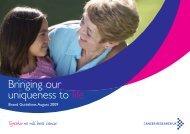
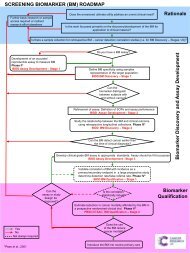
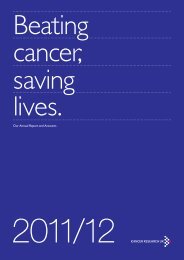

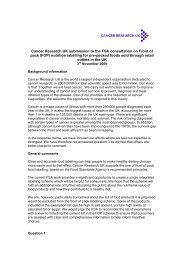
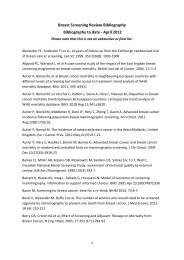
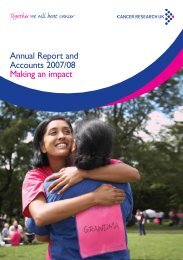
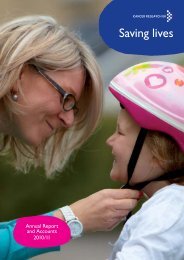
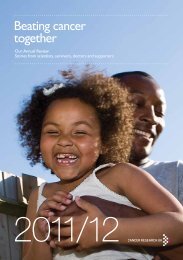

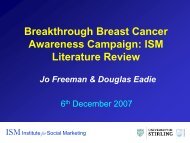
![[PDF] Cancer Research UK's strategy 2009 - 2014](https://img.yumpu.com/29239422/1/184x260/pdf-cancer-research-uks-strategy-2009-2014.jpg?quality=85)
